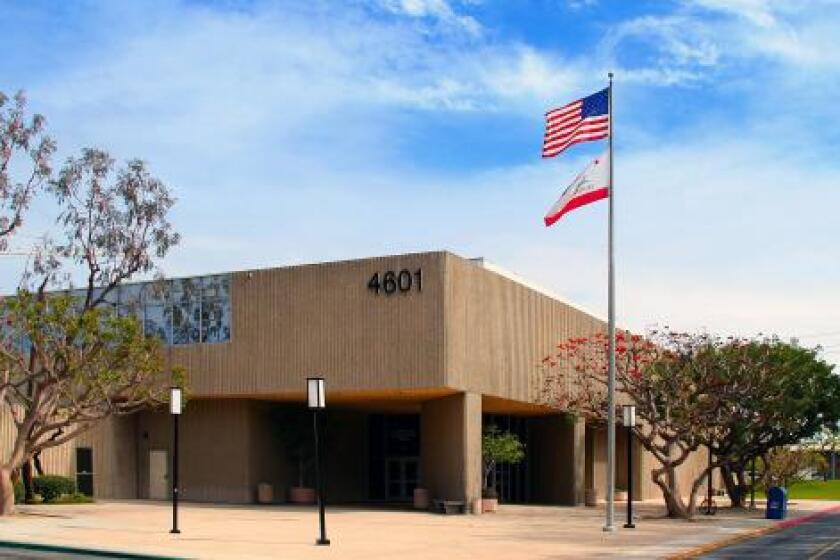Society’s attitude toward Bolsa Chica has changed
- Share via
VIC LEIPZIG AND LOU MURRAY
This summer, the Bolsa Chica Conservancy received a grant from the
Southern California Wetlands Recovery Project to restore the land by
their interpretive building at Warner Avenue and Pacific Coast
Highway. This area, which we’re calling Little Mesa, has seen a lot
of change over the past century, with more changes coming.
The Department of Fish and Game plans to build a boardwalk on
Little Mesa plus a walk bridge over the channel to connect the
parking lot with the trail on Bolsa Mesa. The Bolsa Chica Conservancy
is planting upper marsh and coastal sage scrub vegetation along the
site of the future boardwalk on Little Mesa to enhance habitat for
wildlife and to improve the interpretive value of the area for those
unable or unwilling to walk the entire mesa trail.
That’s where we come in. I’m planning and overseeing the
restoration project with advice from Vic and approval from Brian
Shelton, the Bolsa Chica Ecological Reserve’s biologist.
Our original plan had been to clear large areas of nonnative
vegetation and plant natives. Sounded simple enough. But a close
inspection of Little Mesa revealed native plants everywhere. Upper
marsh pickleweed dominated the landscape. Marsh heather grew in
profusion. We found shoregrass, saltgrass and several other natives.
Finding spots that contained nothing but weeds was actually a
challenge.
That certainly isn’t the case with the main part of Bolsa Mesa.
It’s covered with mustard and wild radish. We wondered why there was
such a big difference between the two upland areas.
The answer to this mystery is the channel that flows under the
Warner Avenue bridge. The channel was cut around 1900 to connect
Bolsa Bay with the portion of Anaheim Bay that is now Huntington
Harbour. The channel separated the western tip of Bolsa Mesa from the
main mesa and saved it from the intense ranching and farming
activities of the past century. Native vegetation flourished on the
isolated portion while weeds took over Bolsa Mesa.
In 1900, isolated dunes stretched for miles along the beach. The
Pacific Electric Railway wouldn’t be built on the dunes until 1904,
and Pacific Coast Highway wouldn’t be constructed until 1928. With
this historical setting in mind, we turned to Tom Talbert’s 1952
autobiography, “My Sixty Years in California.”
We’ve been told that Tom Talbert was hired to cut a channel
between Anaheim Bay and Bolsa Bay to restore ocean flow when the
natural ocean opening to Bolsa Bay silted over in the late 1800s
after construction of a dam. That’s not exactly how Talbert
remembered it. He indicated that the bay closure was deliberate.
In those days, Freeman River fed an extensive marsh system with
year-round flow through the peat bog springs of present-day Central
Park. The huge marsh and surrounding agricultural fields were a haven
for wildlife.
Talbert saw “birds by the thousands so thick in flight as to
almost eclipse the sun” and late afternoon flights of ducks that
lasted for hours, according to his book. Others saw merely a marsh to
be drained, dried, cut into parcels and sold. A state tideland
reclamation act allowed gun club members to acquire title to the
marsh and drain it.
“The natural channel of Bolsa Chica Bay entered into the ocean at
Los Patos,” Talbert wrote. “The reclamation of the tideland
necessitated the closing of this channel and the cutting of a new one
through the mesa and hardpan just east of the Pacific Electric power
plant. The new cut connected Bolsa Chica Bay and Anaheim Bay. Next, a
dam with automatic tide gates had to be built, extending from a point
of the mesa south of the club house to the sand dunes.”
Two earlier dams had washed out. Sea level in upper Anaheim Bay
was a foot lower at high tide than at the Los Patos opening of Bolsa
Bay. Someone reasoned that connecting Bolsa Bay to Anaheim Bay would
enable a more lasting dam to be built.
Talbert cut the channel with Fresno scrapers and road plows pulled
by six-horse teams. While the team and the man holding the plow were
immersed shoulder-deep in seawater, Talbert stayed high and dry on
the banks holding the reins to guide the horses. The plow loosened
the soil, which was carried away by the current. Over the past
century, the tides have continued to work at the banks of the old
channel, widening it year by year.
When the Department of Fish and Game restored muted tidal flushing
to Inner Bolsa Bay in 1978, they also scraped out some upland at
Warner and Pacific Coast Highway. They created two shallow wetland
cells by connecting the scraped out depressions to the channel by
culverts.
In February 2002, the old concrete foundation of the Pacific
Electric Railway power plant was demolished and West Cell was
extended to create wetland where the foundation had been. At the same
time, the old culverts were replaced with larger culverts set at a
slightly lower level to bring in additional seawater.
The wetland restoration project of 2002 has rejuvenated the marsh
plants and endangered Beldings Savannah sparrows have returned to the
site. Now volunteers are planting hundreds of marsh and coastal sage
scrub plants to enhance the habitat on Little Mesa. Tom Talbert
probably would be shocked to see how society’s values have changed
over the past century.
* VIC LEIPZIG and LOU MURRAY are Huntington Beach residents and
environmentalists. They can be reached at [email protected].
All the latest on Orange County from Orange County.
Get our free TimesOC newsletter.
You may occasionally receive promotional content from the Daily Pilot.



